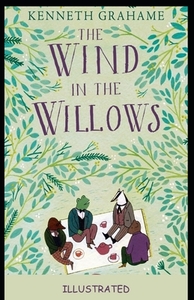You need to sign in or sign up before continuing.
Take a photo of a barcode or cover
A little slow at times but certain parts were so entertaining. I loved the animals and their little personalities and human-like quirks.
Stand outs were the badger and the toad(with his reckless driving). I also got emotional when the mole was sad because he wanted to find his old home and had his little speech about it- it was so relatable. Who hasn’t been talked out of something they really wanted to do because the other person didn’t realise how important it was?
“Poor Mole found it difficult to get any words out between the upheavals of his chest that followed one upon another so quickly and held back speech and choked it as it came. 'I know it's a—shabby, dingy little place,' he sobbed forth at last, brokenly: 'not like—your cosy quarters—or Toad's beautiful hall—or Badger's great house—but it was my own little home—and I was fond of it—and I went away and forgot all about it—and then I smelt it suddenly—on the road, when I called and you wouldn't listen, Rat—and everything came back to me with a rush—and I WANTED it!—O dear, O dear!—and when you WOULDN'T turn back, Ratty—and I had to leave it, though I was smelling it all the time—I thought my heart would break.—We might have just gone and had one look at it, Ratty—only one look—it was close by—but you wouldn't turn back, Ratty, you wouldn't turn back! O dear, O dear!'”
Anyways, it was very cute. The only shame is that there were a few parts that were less interesting to me but it’s a short read so not a big deal.
Stand outs were the badger and the toad(with his reckless driving). I also got emotional when the mole was sad because he wanted to find his old home and had his little speech about it- it was so relatable. Who hasn’t been talked out of something they really wanted to do because the other person didn’t realise how important it was?
“Poor Mole found it difficult to get any words out between the upheavals of his chest that followed one upon another so quickly and held back speech and choked it as it came. 'I know it's a—shabby, dingy little place,' he sobbed forth at last, brokenly: 'not like—your cosy quarters—or Toad's beautiful hall—or Badger's great house—but it was my own little home—and I was fond of it—and I went away and forgot all about it—and then I smelt it suddenly—on the road, when I called and you wouldn't listen, Rat—and everything came back to me with a rush—and I WANTED it!—O dear, O dear!—and when you WOULDN'T turn back, Ratty—and I had to leave it, though I was smelling it all the time—I thought my heart would break.—We might have just gone and had one look at it, Ratty—only one look—it was close by—but you wouldn't turn back, Ratty, you wouldn't turn back! O dear, O dear!'”
Anyways, it was very cute. The only shame is that there were a few parts that were less interesting to me but it’s a short read so not a big deal.
As with AA Milne's Winnie the Pooh, this is at a really high level of literature for little ones. My boys aren't quite old enough to appreciate this one yet, but they certainly will very soon. I love reading this stuff. The character development, the language; it's a beautiful story.
It's not that much of a kids' book, in the end. I mean, to be sure, it's entirely child-appropriate, and it's true that it was originally written with a child (Grahame's son Alistaire) in mind, but it has so many themes and moments—nostalgia, change, newfound freedom, wonderment, wanderlust, faddishness and its hazards, and encounters with the ineffable, just to name a few—that are clearly addressed by an adult to other adults.
There are basically two parallel coming-of-age tales in this book: a sweet, reflective story in which Mole leaves his hole in the ground, falls in love with a river, becomes best friends with Rat and Badger, and learns how to live in a riverbank and mess about in boats; and a sillier (yet equally poignant) story about the famed Mr. Toad of the automotive crashes and the daring if humiliating escapes, who has to learn to reconcile his irrepressible spirit with a bit—okay, a lot—of humility and maturity.
And all of this is depicted in Grahame's elegant, gentle, witty, leisurely style. It's way up there with Watership Down and Haroun and the Sea of Stories among the very best books truly written for all ages. Also, Grahame has a gift for laying his characters' picnic blankets with delicious food. I now know about the British dish called bubble-and-squeak (leftover cooked vegetables reheated with mashed potatoes), which I must now make and eat.
There are basically two parallel coming-of-age tales in this book: a sweet, reflective story in which Mole leaves his hole in the ground, falls in love with a river, becomes best friends with Rat and Badger, and learns how to live in a riverbank and mess about in boats; and a sillier (yet equally poignant) story about the famed Mr. Toad of the automotive crashes and the daring if humiliating escapes, who has to learn to reconcile his irrepressible spirit with a bit—okay, a lot—of humility and maturity.
And all of this is depicted in Grahame's elegant, gentle, witty, leisurely style. It's way up there with Watership Down and Haroun and the Sea of Stories among the very best books truly written for all ages. Also, Grahame has a gift for laying his characters' picnic blankets with delicious food. I now know about the British dish called bubble-and-squeak (leftover cooked vegetables reheated with mashed potatoes), which I must now make and eat.
4 stars given to Grahame's text of this book, but I wouldn't recommend this edition at all. The illustrations, while brightly colorful, are very contemporary with harsh lines and an overall tone that I don't feel reflected the stories particularly well. Some of the characters were represented in a way that I really couldn't get used to. Furthermore, this edition was abridged without any note or reasoning behind leaving out an entire chapter! 2 stars for edition, though I would recommend reading a different edition of The Wind in the Willows to just about anyone.
Very cute and wholesome, different than I remembered as a child!
I read this in 6th grade for a book report and it is now one of the best books I have read in a long time.
lighthearted
medium-paced
"To what scale are these animals?," "Why are they eating meat when they can clearly verbally communicate with other animals?" (The answer, I've decided, is that society always made meat from tofu and vegetable protein and whatnot in this world), and "Why does that toad have hair?" are all questions that reappeared periodically in my brain whilst reading this. And to tell you the truth, if I were rating purely on enjoyment alone, these would drag it down to a 3. But, of course, this is a story conceived and told for one boy who clearly did not find much concern in these issues, and that delightful personal aspect that elevates so many children's novels has to be kept in mind. (Begrudgingly, I have to accept the disappointing answer to "Where are all the female critters?" for this reason too.)
The real saving grace in this story, anyhow, is not to be found in the story. It's in Mole and Badger and Rat and Toad and their caring dynamic and the subtle assessment of class politics that lies within them. They're complex characters under a veneer of childish simplicity, with varying degrees of connectability but all with the same amoun of lovableness.
You'll note that I abstained from mentioning any of the less connected chapters here, because those would be done a disservice in being conflated with the main story, which I unfortunately did for all but one: Dulce Domum, the first of its kind. A small, down to earth, and monologuing tale about the Mole and his home. It's incredibly sweet and is bound to connect with anyone who has ever had to leave a place they've felt welcomed in behind. Wayfarers All, meanwhile, found me bored and wanting to get back to the story, and The Piper at the Gates of Dawn had me making quiet noises of exasperation and befuddlement to myself whilst I tried to resolve its seeming disconnect from the tone of everything surrounding it. I suspect that, had I been able to appreciate the disconnected nature of these two, the book would have stood stronger to me overall.
The real saving grace in this story, anyhow, is not to be found in the story. It's in Mole and Badger and Rat and Toad and their caring dynamic and the subtle assessment of class politics that lies within them. They're complex characters under a veneer of childish simplicity, with varying degrees of connectability but all with the same amoun of lovableness.
You'll note that I abstained from mentioning any of the less connected chapters here, because those would be done a disservice in being conflated with the main story, which I unfortunately did for all but one: Dulce Domum, the first of its kind. A small, down to earth, and monologuing tale about the Mole and his home. It's incredibly sweet and is bound to connect with anyone who has ever had to leave a place they've felt welcomed in behind. Wayfarers All, meanwhile, found me bored and wanting to get back to the story, and The Piper at the Gates of Dawn had me making quiet noises of exasperation and befuddlement to myself whilst I tried to resolve its seeming disconnect from the tone of everything surrounding it. I suspect that, had I been able to appreciate the disconnected nature of these two, the book would have stood stronger to me overall.






